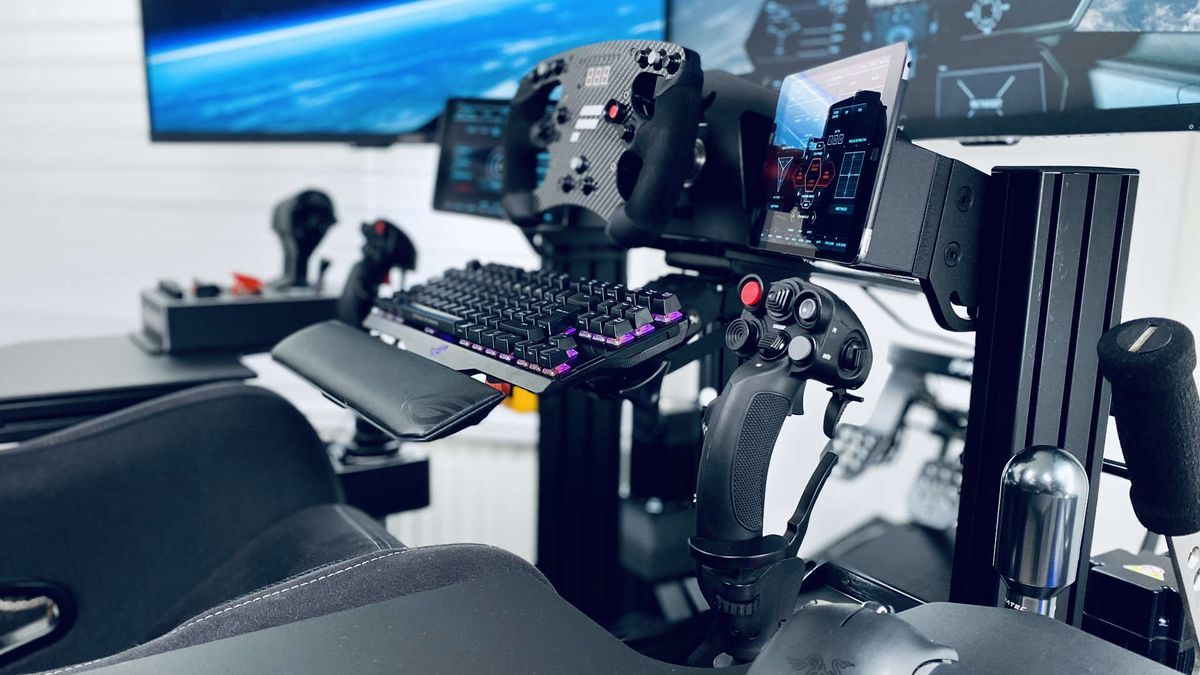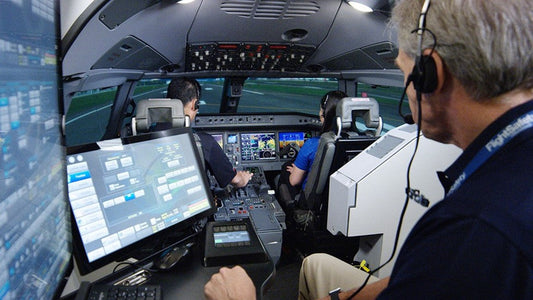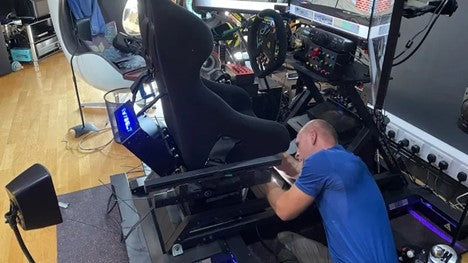How to Avoid Simulator Sickness

Figure 1: A Race and Flight Sim Rig
Simulator sickness can be a big turn-off for anyone who loves simulation. Not only does it ruin the element of immersion but can also become dangerous if ignored for too long. While scientists are still trying to figure out the exact causes of simulator sickness, there’s no definitive cure yet.
Simulator Sickness – What Is It?
Understanding simulator sickness is the first step toward managing it effectively. Before we see how to prevent simulator sickness, let’s first understand what is it so that you’re sure it is what you are actually experiencing.Simulator sickness is a type of motion sickness caused by the use of simulator systems and virtual reality systems. It's like travel sickness; that is, the brain is overloaded by too much information as one sense fails to correlate with the other senses. For instance, if someone is receiving stimuli from an active visual simulation with their eyes, yet their body is still and not moving, it sends mixed signals to the brain which activates (or turns off) various brain functions in a way it is not supposed to be activated (or turned off). This conflict often triggers symptoms such as dizziness, nausea, headaches, or even fatigue.

Figure 2: A Woman Feeling Motion Sick From a VR Simulator
Simulator sickness is a byproduct of training with simulated environments. It limits how long users can comfortably engage in the simulation and can reduce focus during tasks. For trainees, this discomfort can interrupt learning or diminish their ability to absorb vital information. Over time, this decreases interest in future simulated training sessions which, in turn, decreases the success of missions and training. Therefore, it becomes all the more important to follow tips for avoiding simulation sickness if you’re into sim gaming or enrolled into some sort of simulation program like FlightGear or Simulink.
Reason Why You Might Experience Simulator Sickness
Simulator sickness happens when your brain struggles to make sense of conflicting signals from your senses. This confusion typically occurs during simulation activities because what your eyes see doesn’t match what your body feels. For example, when one is engaged with a driving or flying simulator, the projected imagery is, without a doubt, moving; however, the vestibular system that controls the sense of balance does not acknowledge that degree of movement. This mismatch phenomenon within the human body is known as sensory conflict, which is one of the most common explanations of simulator sickness.
Figure 3: A Person Driving a Racing Simulator
Another contributing factor is latency or lag in the simulation. When one moves the joystick and what appears on the screen occurs with even a moment of delay, it only increases your feeling of nausea. This is because your brain relies on precise timing to process movement, and when it doesn’t, it makes the experience feel unnatural and overwhelming for your body.
Another thing to add here is the environmental stressors such as no airflow, fresh air, tight quarters, and a detachment from what's actually being simulated. When one or more of these things are combined, it can cause even more unpleasant feelings resulting in severe motion sickness.
Moreover, some people are naturally more prone to simulator sickness than others. This sensitivity can depend on an individual’s vestibular system, the part of the inner ear that controls balance and spatial orientation. Fatigue, stress, or even how familiar you are with simulators can also influence how likely you are to feel sick. For some, simulator sickness is like seasickness - it becomes more manageable over time as the body adjusts, but for others, it may persist until preventive measures to avoid simulator sickness are taken.
Simulator Sickness Symptoms

Figure 4: A Motion-Sick Woman About To Vomit
Simulator sickness can show up through a range of uncomfortable symptoms that make it difficult to continue enjoying or learning from simulations. Here are some common signs to watch out for:
- Nausea: An upset stomach. When what's seen does not match the body's perception, the brain becomes confused which almost always results in stomach distress, similar to what you might feel when you’re carsick.
- Dizziness: It is the feeling of spinning or losing one's balance when what the body feels does not align with what's going on in the vestibular system (inner ear) and visual input (eyes), it fails to stabilize.
- Cold Sweats: This is the reaction of your body in distress as it feels conflicted with the stimulation and subsequently responds in such a way.
- Fatigue: Fatigue is when you feel unusually tired or drained even after a short session in the simulator because your brain is working overtime to process conflicting sensory inputs.
- Migraines/Headaches: This is the effect of your overexerted eyes trying to focus on imagery that exists virtually, yet does not align with how your body feels, creating migraines and persistent headaches.
- Disorientation: A sense of confusion or being “off-balance” when you're not in control of your body, which can be problematic during simulations as you need to remain engaged.
With that said, carry on reading to find out how to avoid simulator sickness when you experience these symptoms.
How to Avoid Simulator Sickness?

Figure 5: A Man Racing in a Sim Tournament
Gradual Exposure to Simulations
One of the most effective ways to prevent simulator sickness is by gradually building your tolerance to simulations. Start with shorter sessions of about five minutes and give your brain a chance to adapt to the new environment. After each session, take a break, allowing your senses to reset before progressing to longer simulations. Over time, this controlled exposure will help your brain understand the sensory conflicts and reduce discomfort significantly. This approach is especially helpful for those new to simulation or highly sensitive to motion sickness.Invest in High-Quality Equipment
High-quality equipment ensures top-level comfort in any simulator experience. For example, using higher-resolution screens with higher refresh rates results in smoother graphics which, in turn, are easier on the eyes and less nauseating. Always opt for equipment that allows for low-latency connection and operation. Like if you're running the simulation through an additional graphics card, more expensive options like NVIDIA's RTX 4090 will help reduce lag or choppy visuals.Similarly, ensure your system is well-calibrated and that the visual settings are adjusted to match your personal preferences and comfort level. Whether it's brightness, contrast, or motion sensitivity, your simulator rig should be fine-tuned to enhance immersion without causing any motion sickness.
Maintain a Comfortable Environment
Another great tip for avoiding simulator sickness is a stable, well-ventilated, and distraction-free environment. Ensure you are sitting properly so you are neither too distant from the screen nor too near. Being too near makes eyesight and the brain work harder to focus which can amplify feelings of disorientation. Don't sit in a dimly lit room where you have to squint your eyes to see. If you cannot move your setup then tweak the screen brightness and contrast so that there is no eye strain. Make sure the place where you sit in a simulator has an ergonomic design that supports a good posture. In addition, keep your room airy and at a pleasant temperature since poor ventilation can lead to overheating and add to the physical stress of using a simulator.Adjust Settings and Calibrate Properly
Fine-tuning your simulator settings can make a world of difference. As mentioned above, if the motion sensitivity is high, locking it at a comfortable value will make it easier for the brain to process what's going on. For example, reducing motion blur or disabling "camera bobbing" helps those who are sensitive to high motion sensitivity. Likewise, if the person feels the simulation has a lot of fast movement or annoying flashing, then lowering the frame rate or field of vision will result in slower, easier cognitive processing.On top of that, regularly calibrate the simulator to align with your physical positioning, including adjusting the angles and heights of screens for an optimal perspective. It’s a great tip for avoiding simulator sickness since proper calibration bridges the gap between the virtual and physical environments, reducing sensory mismatches.
Conclusion

Figure 6: A Woman Driving in a Racing Simulator
Although simulator sickness can be a very frustrating experience, know that it is not insurmountable. You can avoid simulator sickness and significantly reduce its effect by simply following the steps highlighted in this article. In addition to all of the above-mentioned steps to prevent simulator sickness, you can also try taking regular breaks from your sim rig as well as practicing focus techniques to help you concentrate better while in a simulation.





